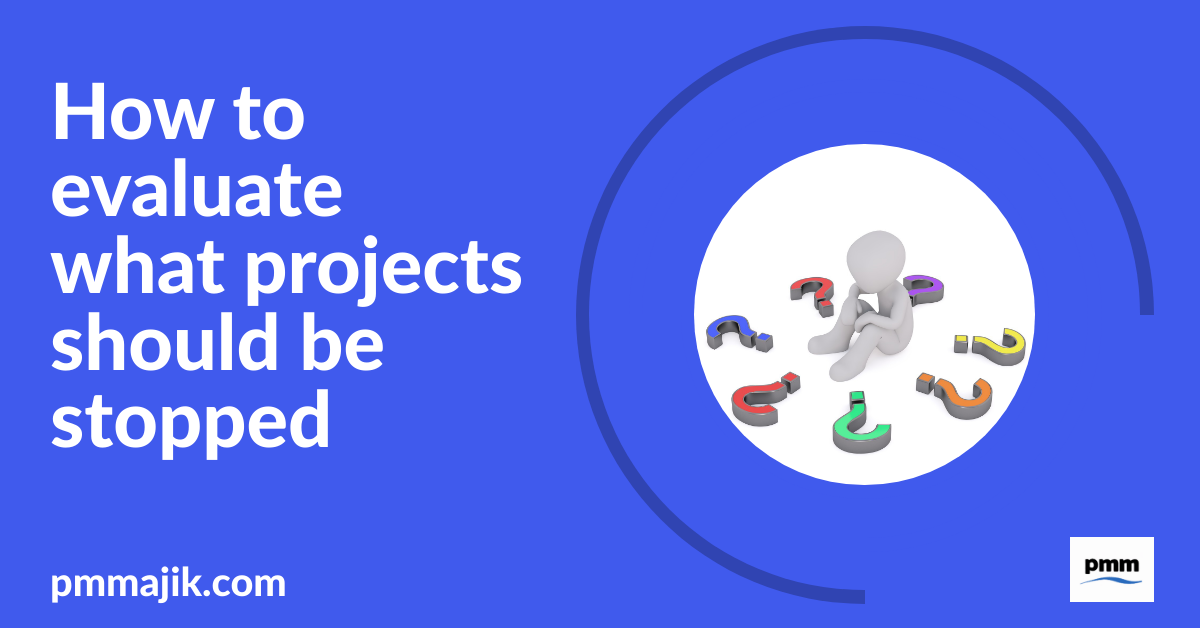In the last post, Reasons to stop projects before completion, it covered reasons why projects were allowed to complete when they should be stopped and 3 checks that could be performed. One of the main reasons for many projects being left to continue is based on emotional decisions as opposed to balanced business decisions based on facts. Being able to capture and evaluate the data in a non-emotional way, using agreed metrics, is critical to helping people to make the right decision.
Process to evaluate projects to stop
Like with many things project delivery, you need to define a robust process, agreed with stakeholders that will stand up to scrutiny. Gaining agreement is a very important step. I have found that it is far better to explain and agree the process before the evaluation as, it makes it easier for the stakeholders to understand how the results have been reached and make them easier to accept. It also makes it difficult for a member of senior management to go back on their agreement in front of their peers just because they do not like the results.
The steps you need:
- Define the tools and process
- Capture the project data
- Review and challenge submissions
- Finalise analysis and findings
- Present and communicate results
- Stop projects
1. Define the tools and process
It is important that the tools and process have been thought about and designed so as to perform the required task. Key to this is designing the criteria for evaluating the projects. Metrics that could be used:
- Alignment to strategy
- Return on investment
- Performance to date (if a project has a poor track record of delays and budget increases, may be too high risk)
For each metric there should be a clear understanding of how the evaluation will be made in a fair, balanced way. For example, you may add a Strategic (Yes / No) flag to the inputs. You need to know how you will assess those marked Yes.
If you do not have a project / portfolio tool, you can use a spreadsheet to gather the data as it will allow for data analysis and calculations.
Make sure that the process is reviewed and agreed with the stakeholders who will be making the final decision.
2. Capture the project data
Now you have an agreed process, criteria and tools, you need to collect the project data. If you have a PMO, they can add value by pre-populating the template as much as possible with the available data. However, you do not own the data. It is very important that it is sent to the appropriate project sponsor to validate, complete and sign-off. This ensures that the sponsor can not complain that their project was unfairly represented.
3. Review and challenge submissions
When all the data has been returned, the PMO can consolidate and evaluate each project using the agreed process and criteria. It is a good idea to start the review and evaluation as you receive the submissions as you will usually find that there are data errors, points requiring clarification, misuse of templates to suit the project, etc. It is very important to ensure the data is clean, fairly represents the state of the project and has been judged without bias.
4. Finalise analysis and findings
When all submissions have been received and data clarified, the results can be finalised. It is worth the PMO or other project managers conducting peer reviews if possible of each others work. This helps ensure that no errors have been applied or unconscious bias. It should also be possible to track back the findings to the submission from the project so that any recommendations can be supported by fact. The results should be consolidated into an easy to understand presentation.
5. Present and communicate results
The results should be presented to senior management for final approval. They should test that the process has been applied fairly, review the results, check to ensure that there is no important missing data in the decision process i.e. they be aware of a pending change in strategy that may make some projects strategic that are currently tactical, etc and as a conclusion, reach agreement on the projects to be stopped.
The decisions must be communicated by senior management. If there are sensitive decisions that will impact employees if a project is to close. The sponsor should be consulted and it may make sense to communicate to the project team ahead of the general communication.
6. Stop the projects
It is hard work to get to step 5 and have agreement of what projects to stop. However, step 6 is really hard. Projects can continue for many months even though they are to be closed. When the decisions are communicated, the PMO should work with the sponsor and project manager to agree a timely closure, including all of the correct governance steps. As resources make up a key part of many projects, it is beneficial to review the capabilities so that they can be quickly redeployed where possible.
The PMO should provide metrics as part of their regular MI packs to show the projects being closed and status (including when they have been closed).
In summary
Taking tough decisions to stop projects early is hard. You need to make sure that there is a fair process to conduct the reviews and reach the decisions. Using the 6 steps above will provide a good framework to execute the process. This will result in the organisation to better utilise their scarce resources on strategic initiatives.







